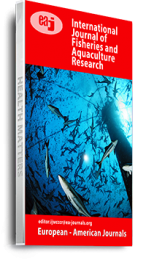The present study was conducted to evaluate the use of maggot meal as a protein source in the place of fish meal to feed tilapia Oreochromis niloticus at different stages of growth. The average weight for larval stage (ST1) was 20 ± 4 mg and those of juvenile stage (ST2) and adult stage (ST3) were ranged respectively from 0.62-0.75 g and 20-29 g. The control diet (fish diet [FD]) and the commercial diet (CD) were used to compare the test diet (maggot diet [MD]). The fish were fed four times daily to triplicate groups at 30-20% body weight for consecutive 30 days for ST1 and at 10-7% body weight for consecutive 90 days for ST2. Concerning the adult stage, fish were fed twice times daily to duplicate groups at 5-2% body weight for consecutive 180 days. After this days, fish fed with MD had the highest (p ≤ 0.05) mean daily gain (ADG) (24.33 ± 10 mg.day-1, 0.3 ± 0.03 g.day-1 and 1.80 ± 0.83 g.days-1 respectively ST1, ST2 and ST3) compare to those obtained by fish fed FD (22.9 ± 20 mg.day-1, 0.22 ± 0.18 g.day-1 and 1.59 ± 0.79 g.days-1 respectively ST1, ST2 and ST3). Therefore, the fish fed with CD had the lowest (p≤ 0.05) ADG (20.2 ± 10 mg.days-1, 0.19 ± 0.12 g.day-1 and 1.47 ± 0.86 g.days-1 respectively ST1, ST2 and ST3) than those obtained by FD. The specific growth rate (SGR), feed conversion ratio (FCR), survival rate (SR), the production cost of 1 kg of fish (PC) and the carcass chemicals composition were evaluated. In conclusion, these results of this study indicate the possibility of completely using maggot meal as a source protein in the diet of Oreochromis niloticus at different stage of growth to increase the growth of this specie and reduce the cost of 1 kg of fish produced.
The present study was conducted to evaluate the use of maggot meal as a protein source in the place of fish meal to feed tilapia Oreochromis niloticus at different stages of growth. The average weight for larval stage (ST1) was 20 ± 4 mg and those of juvenile stage (ST2) and adult stage (ST3) were ranged respectively from 0.62-0.75 g and 20-29 g. The control diet (fish diet [FD]) and the commercial diet (CD) were used to compare the test diet (maggot diet [MD]). The fish were fed four times daily to triplicate groups at 30-20% body weight for consecutive 30 days for ST1 and at 10-7% body weight for consecutive 90 days for ST2. Concerning the adult stage, fish were fed twice times daily to duplicate groups at 5-2% body weight for consecutive 180 days. After this days, fish fed with MD had the highest (p ≤ 0.05) mean daily gain (ADG) (24.33 ± 10 mg.day-1, 0.3 ± 0.03 g.day-1 and 1.80 ± 0.83 g.days-1 respectively ST1, ST2 and ST3) compare to those obtained by fish fed FD (22.9 ± 20 mg.day-1, 0.22 ± 0.18 g.day-1 and 1.59 ± 0.79 g.days-1 respectively ST1, ST2 and ST3). Therefore, the fish fed with CD had the lowest (p≤ 0.05) ADG (20.2 ± 10 mg.days-1, 0.19 ± 0.12 g.day-1 and 1.47 ± 0.86 g.days-1 respectively ST1, ST2 and ST3) than those obtained by FD. The specific growth rate (SGR), feed conversion ratio (FCR), survival rate (SR), the production cost of 1 kg of fish (PC) and the carcass chemicals composition were evaluated. In conclusion, these results of this study indicate the possibility of completely using maggot meal as a source protein in the diet of Oreochromis niloticus at different stage of growth to increase the growth of this specie and reduce the cost of 1 kg of fish produced.
Keywords: Nil tilapia, maggot feeds, zootechnic and economics parameters

